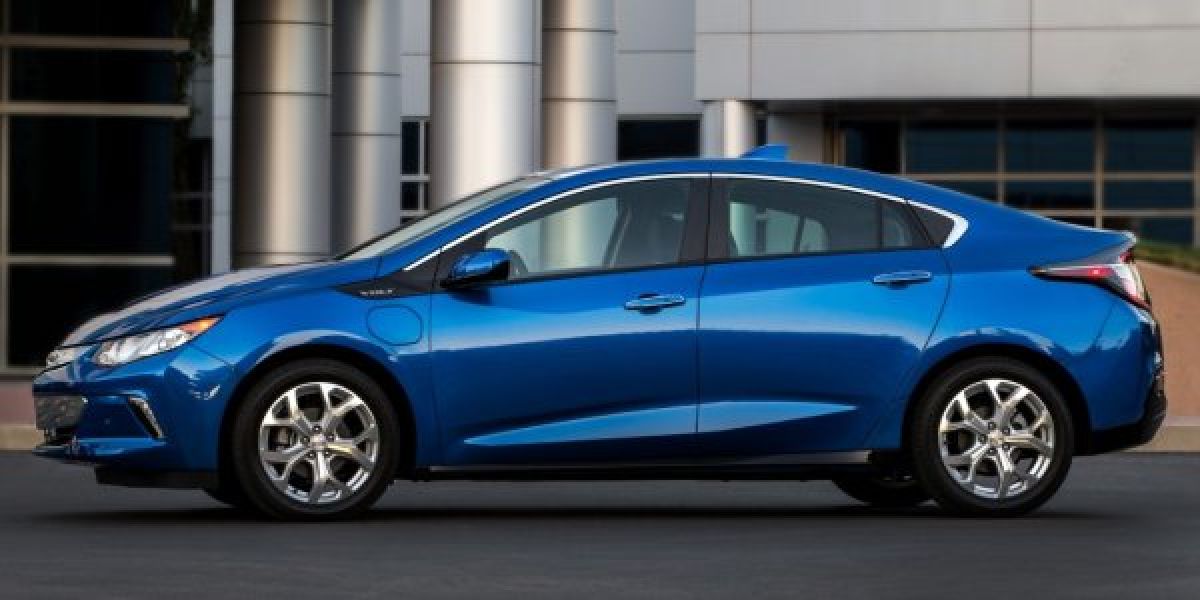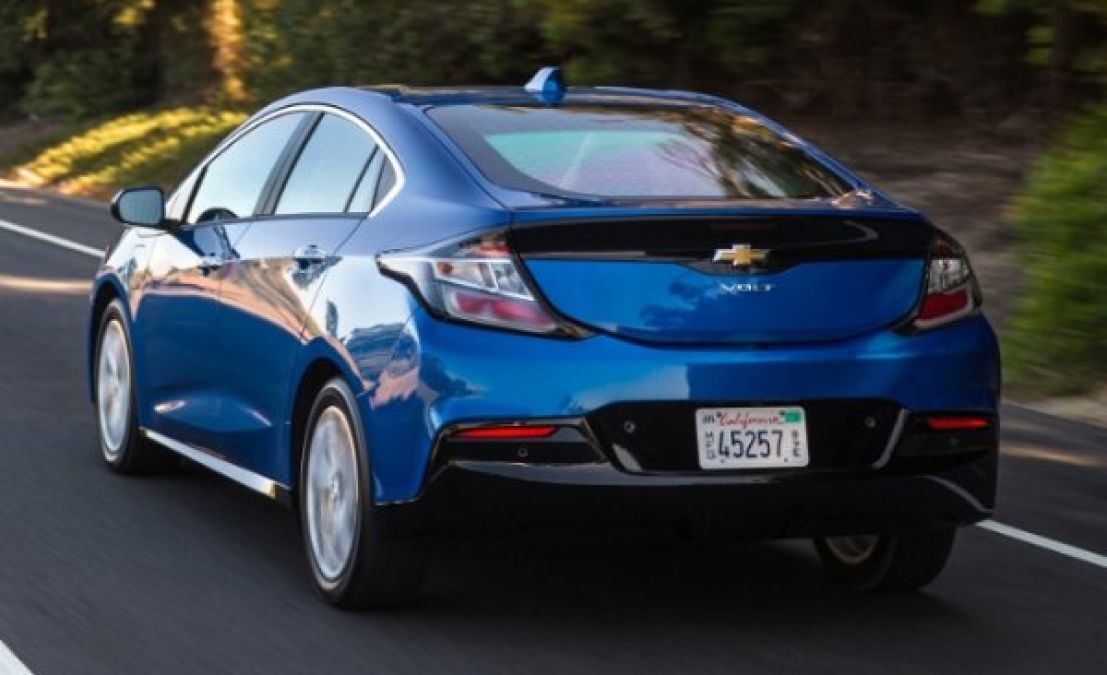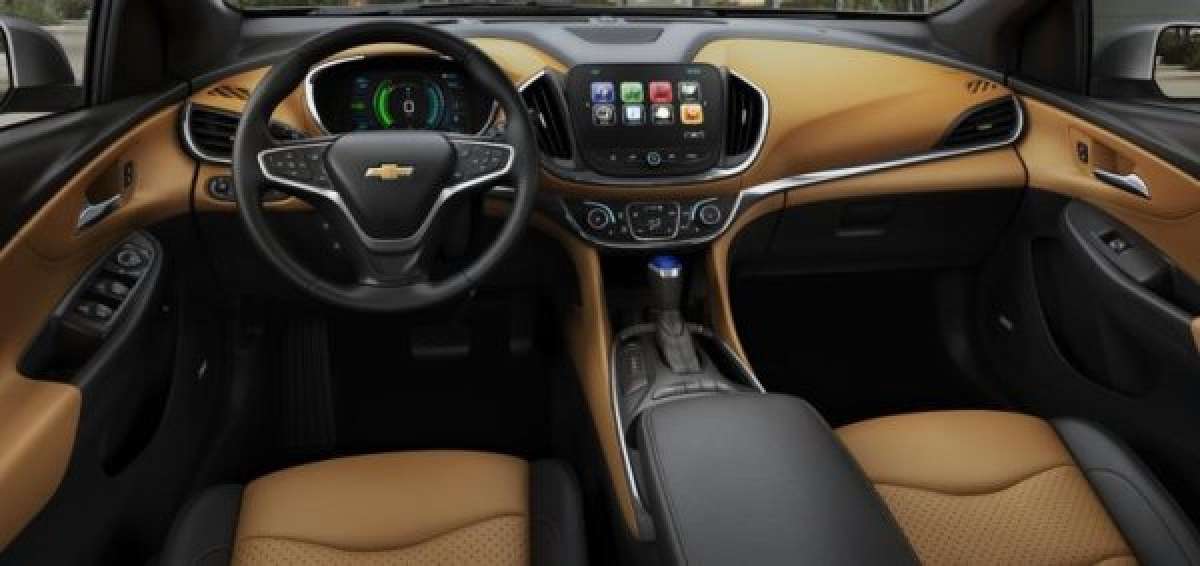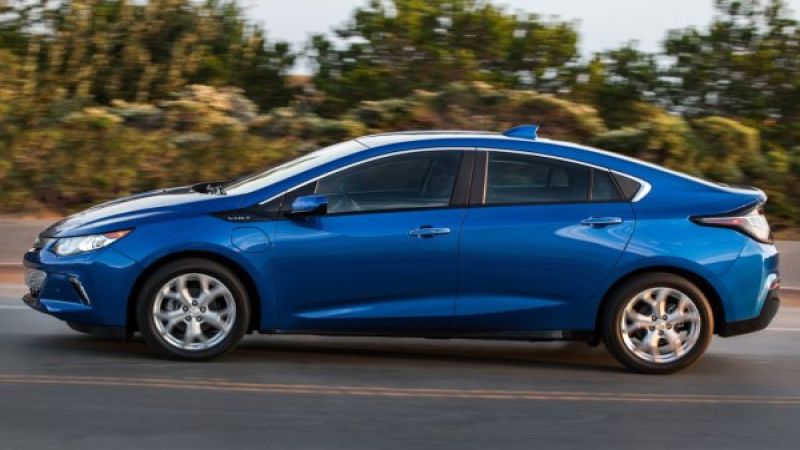While I prefer hardworking trucks and high performance cars, I can appreciate the design of some people to drive without the use of gasoline. At the same time, having tested and enjoyed a few different electric vehicles, I am aware of the shortcomings of a pure EV in terms of range limitations and that is why I like the Chevrolet Volt so much.
Since my first time testing the 1st gen Volt a few years back, I have been impressed with the driving dynamics of this small sedan along with the all-electric range combined with the endless range of the gasoline engine. The Volt offers more true EV driving than the many plug-in hybrids and a proper electric driving experience regardless of the speeds or driving situati8ons, but unlike the pure EVs sold in America – you never really need to worry about running out of battery power with the Volt.
The Chevy Volt combines all of the advantages of an electric vehicle with the endless range of a traditional economy car with a gasoline engine, and with the arrival of the 2nd generation Volt for the 2016 model year – the Volt is promised to be better in every way.
The 2016 Volt has a new, larger battery system and a new, more efficient range extending gasoline engine, leading to improved capabilities across the board. The new Volt has improved all-electric range (53 miles), improved MPGe (106), improved gas-only fuel economy (42mpg) and an improved overall range on a full charge and a full tank of gas of 420 miles.
Those numbers are all great on paper, but how do these improvements translate into the real world? I set out on a week of driving the 2016 Chevy Volt to answer that question and in the end, I was surprised to find that in my driving conditions, the new Volt is even more efficient than the EPA estimates.
Test 1: Normal Daily Drive
My first test with the 2016 Chevrolet Volt was what I considered to be a pretty normal daily drive route, with an even 50/50 mix of highway (22.8 miles) and non-highway driving (22.9 miles). This drive would take me from my residential area to a very busy commercial area – a trip that many of my neighbors make each day – so it is an excellent “average commute” drive route.
When I left in the morning, I had 44 miles of electric range and when I mapped out my trip for the day, I had to drive 45.7 miles. I was curious to see if I could get there and back without using any gasoline, but based on my available range, it would be close. I didn’t drive in a way that would generally improve electric range, with speeds on the highway varying from 70-75mph and speed on the non-highway roads typically being 45-55mph. Traffic on all roads was moderate, but it was moving, so there was very little stop-and-go and when I returned home, I had gone the expected 45.7 miles and I hadn’t used any gasoline in the process.
In fact, when I returned home, even though I had driven 45.7 miles with 44 miles of EV range when I left the house, I still had 12 miles of range left on the battery system. Even if I had “only” gotten 12 more miles out of the system, I would have exceeded the expected EPA range by 4+ miles with roughly 57 miles driven on the battery. I averaged 111 MPGe during this trip.
Based on these results, I believe that driving this route or a similar route each day with the 2016 Chevy Volt could easily yield 60 miles of all-electric driving…especially if you put some effort into getting better range.

Test 2: Hard Driving
So, when the 2016 Chevrolet Volt is driven on a normal daily drive route, running with traffic at speeds around the posted limits, it is possible to meet and exceed the EPA range expectations. When the Volt is driven reasonably, like most drivers will drive it, it posts awesome efficiency figures, but I wondered what might happen if I drove the Volt in a way that should, in theory, yield terrible range numbers. So, I took the new Volt out for a day of simple errands around town, but I drove like I was in a huge hurry the entire time. Lots of hard acceleration, higher speeds on a few miles of highway driving, hard braking – basically driving as poorly as I could picture someone driving this car. I drove all in Sport mode with the radio on, the AC on, the windows open and the headlights on. Really, if you drove any average gasoline powered car like this, you would experience vastly reduced fuel economy numbers, so I expected that driving aggressively would lead to poor electric efficiency numbers as well.
Turns out, I was wrong.
I started out on this trip with the 2016 Volt with 49 miles of EV range and put 25 miles on the car during the course of my day and when I was done, I had an astonishing 38 miles of my initial 49 remaining. In driving 25 miles as inefficiently as possible, I still only used 11 miles of EV range and in doing so, I averaged 117 MPGe.
I got better efficiency results driving inefficiently around town than I did driving normally during my average daily commute test, so even if you are driving to intentionally be inefficient – as long as you are driving as speeds below 50mph or so, you are still going to get incredible EV range with the new Volt.
Test 3: The Closest Thing to A Weak Spot
For my 3rd test, I wanted to see how the 2016 Chevrolet Volt would handle pure highway driving as higher speeds. High speed highway driving is the hardest on all modern electric drive systems and in any EV, this type of driving will deplete your battery power the quickest.
I started out with 49 miles of electric range and my trip was entirely highway driving, with speeds averaging around 75mph in Detroit’s fast-moving traffic. I drove 24.3 miles, with only about 6 miles driven getting to and from the highway between my house and my destination, and when I got back to the house, I had 22 miles of range remaining. This means that in making this highway speed drive, I used 27 miles of range to go just over 24 miles.
While on the highway, I noticed that the efficiency gauge in the cluster was almost never in its ideal spot when driving over 75 miles per hour. When I hit traffic that reduced my cruising speeds below 70, the efficiency gauge would get to the prime spot, but when you are driving above 75 miles per hour, you are most certainly burning battery power more quickly than the system prefers. In other words, if you spend lots of time going 80mph on the highway with the new Volt, you are not going to be able to get to the expected EPA all-electric range of 53 miles, but driving at speeds that most Volt owners would consider extreme seems to be the only way to really hurt the efficiency of the 2nd gen Chevy Volt.

Test 4: A Day of Driving
My final test was to see what would happen if I had to drive the Chevrolet Volt well beyond any possible EV range without charging the battery back up in the middle of the day. With all of my other tests, I made relatively short trips, as that is the type of driving that the Volt and all EVs are designed to handle the best, but for my final test, I wanted to see what would happen if I had to drive a hundred miles in a day without having time to recharge in the middle of the day. I did keep efficiency in mind for this test, so I used the regenerative braking paddle on the steering wheel in addition to braking mindfully in order to pick up some extra juice while slowing down. I also tried to keep the efficiency gauge in the sweet spot to get the best range possible, and I was very impressed with my end results.
I started off the day with 49 miles of EV range on the gauge cluster and my day included around 40 miles of highway driving and around 60 miles of non-highway driving. I did not have access to a high speed charging station, so I had no choice but to dig into the gas tank for some extra range. I ended up with 0 miles of EV range remaining, but I had driven just shy of 60 miles on the battery. Also, the 41.2 miles on the gasoline engine were run with just 0.99 gallons of gas burned.
In total, my daily trip with the 2016 Volt was 101.1 miles, with 59.9 of those being electric miles and the other 41.2 being run with the gasoline engine. This gave me an overall MPGe rating of 58.3 and a gas-only figure of 41.6mpg. Overall, my 101.1 mile trip brought about an average of 102.12 miles per gallon.
Test Results
As you can see by the test by test results, the 2016 Chevrolet Volt is very capable of meeting and exceeding the EPA expected electric range numbers, especially if you don’t do much highway driving. If your daily commute is less than 60 miles total and your topography is similar to that of Metro Detroit, I believe that you could make your drive almost every day without ever using any gasoline and even if you do need to go slightly further than 60 miles – or if you spend a great deal of time driving on the highway – you would need to run the new Volt consistently at speeds over 75mph to really cut into the expected EPA range.
Driving Dynamics
While all super-efficient vehicles like the 2016 Chevrolet Volt are designed to optimize efficiency and the people who buy them are most concerned about efficiency, no one wants to drive a car that rides and handles like crap so driving dynamics were another key factor for the team when building the new Volt. The new gasoline engine and battery system are lighter and more efficient, but they are also more powerful – with an impressive peak torque figure of 294lb-ft. The electric drive system applies that torque as soon as you hit the gas pedal, and particularly when set to Sport mode, the new Volt accelerates very quickly from a stop. In fact, the Volt puts power to the ground quickly enough to spin the wheels from a stop and even when you are rolling at speed, putting the pedal to the floor will get the Volt moving out very quickly.

Whether you are trying to merge into fast-moving highway traffic or just trying to hurry ahead of slower moving traffic around town, the 2016 Volt never feels like it is short on power…and that is coming from a reviewer who owns 4 vehicles with more than 400hp of V8 power. Mind you, the Volt isn’t going to keep up with performance cars, but it will deliver a more engaging driving experience than the vast majority of the hybrids on sale today thanks to the characteristics of the electric drive system.
Finally, even with the fairly rigid, low rolling resistance tires that come standard on the 2016 Chevy Volt, this new EV seems to handle a touch better than the outgoing models. Around town, the Volt has no issue zipping in and out of traffic with ease, and you can even have some fun carving the corners of some twisty backroads. When you do push the Volt a bit too hard in a tight corner, the tires will quickly let you know it, but under normal driving situations around town and on the highway, the Volt is smooth, comfortable, quiet and very pleasant to drive. Really, it isn’t going to blow you away with its cornering and road-handling abilities, but it unlike many hybrids and other super-efficient models – the Volt is far more enjoyable to drive in most situations.
Interior Comfort and Pricing
My 2016 Chevrolet Volt test car was fitted with the Premier trimline, which includes all sorts of amenities inside to give this compact electric sedan the interior feel of a luxury car. This interior could be lifted out of the Volt and plugged into a small Cadillac and it would work just as well, which should give you an idea of the fit and finish of the 2016 Volt cabin.

Most notably, my Volt featured the Jet Black and Brandy interior spread, which applies the black-and-brown two tone treatment to the dash, the door panels and the plush heated leather seats (front and rear). The front seats are comfortable and spacious, proving plenty of space in every dimension for very tall drivers while adjusting enough to accommodate very short drivers. The back seats are comfortable in terms of the seating surfaces, but taller adults might find the rear footwells to be a bit cramped, especially if the front seats are adjusted for a very tall driver and front passenger. If you adjust the front seats carefully, you can make the Volt comfortable for 4 adults of roughly 6 feet tall, but this is really a better vehicle for someone who is going to be carting around two adults and a kid or two.
In addition to the luxury level seating and two-tone layout, the 2016 Volt Premier comes with a premium infotainment system the wraps up all of the interior functions into one easy to use screen mounted high on the center stack. From the big, bright screen, you can access the electric drivetrain information (including range and charging preferences), the sound system, the media system, the navigation software, the hands-free phone system and all of the basic interior settings. In addition to the touchscreen, the new Volt also has a small spread of buttons and knobs for the media players/radio and below that is a climate control system that relies entirely on traditional buttons and knobs – no more haptic controls to confuse people.

My 2016 Chevrolet Volt Premier test car was priced at $39,850 and while that is a big chunk of change for a small sedan, readers should keep in mind that the Volt is subject to the various tax credits that you get when buying an EV. Depending on your area, you can get $7,500 or more in tax credits, effectively reducing the purchase price into the $33k range. At $33k, it still costs more than your average compact sedan, but when you consider the fact that the 2016 Volt Premium has a Cadillac-like interior and an electric drivetrain that will yield well over 50 miles of all-electric driving each day, there is potential to make up that added cost by never buying gasoline.
The Final Word
If you are someone who drives less than 60 miles a day for your commute, the 2016 Chevrolet Volt will almost completely free you of making stops at the gas station with any regularity. The Volt is fun to drive, comfortable and very well appointed and while offering great all-electric range – the gasoline engine guarantees that you will never need another car if you do need to make longer trips. The Volt is the ideal EV for someone who can make use of the 50-60 mile EV range, but someone who also wants to be able to drive the car a few hours away for a family trip from time to time.
The 2016 Chevrolet Volt is, in my opinion, the best electric vehicle on the market today simply because it will do what every other EV will do in terms of getting you from point A to point B, but it will also function as a normal economy car when the battery has been run dry. The Volt offers the benefits of an EV, the freedom of a traditional gasoline drivetrain and the interior of a Cadillac for under $40k and to me, that makes it better than any of the competitors.












Comments
Hello Mr. Rall,
Permalink
Hello Mr. Rall,
Thank you so much for this very thorough review that covers driving over a number of days versus many reviews that cover a few hours. Your commentary is very digestible and easy to absorb. I hope I like the test drive in the Volt because everything you say about it is exactly what I am looking for.
I have driven a 2007 Prius for the last 10 years and am looking to further reduce my carbon footprint not to mention going to a gas station. We have PV and can charge nightly.
Again many thanks for a great review. Trust me, I know. I have seen every reviewer out there!
Happy driving,
Lorie
EXCELLENT thorough review!
Permalink
EXCELLENT thorough review! The different driving scenarios are exactly how one should review a vehicle like this; they were all very informative.
With government incentives and longterm gasoline savings, the Volt can be cheaper than a typical compact vehicle like a Corolla or Civic—but, as described in this article, you cannot begin to compare the quality & performance with the Volt.
To make the Volt even more
Permalink
To make the Volt even more useful I'd like to see an electric outlet that would
be a power-out source (generator) for household electric power outrages.
Such a system may be available on the upcoming Toyota Mirai
Thanks for the great review.
Permalink
Thanks for the great review. Really liked the different driving scenarios. Wish more people did that. You can pick which one fits your driving style ahead of time. We just got our 2016 Volt. love the plush interior and let me say "The guy that came up with that Regen paddle should be made a is a saint in EV Heaven" love it. We get 70 miles on a charge if you take it easy on the right foot and use the regen to slow instead of the friction brakes.